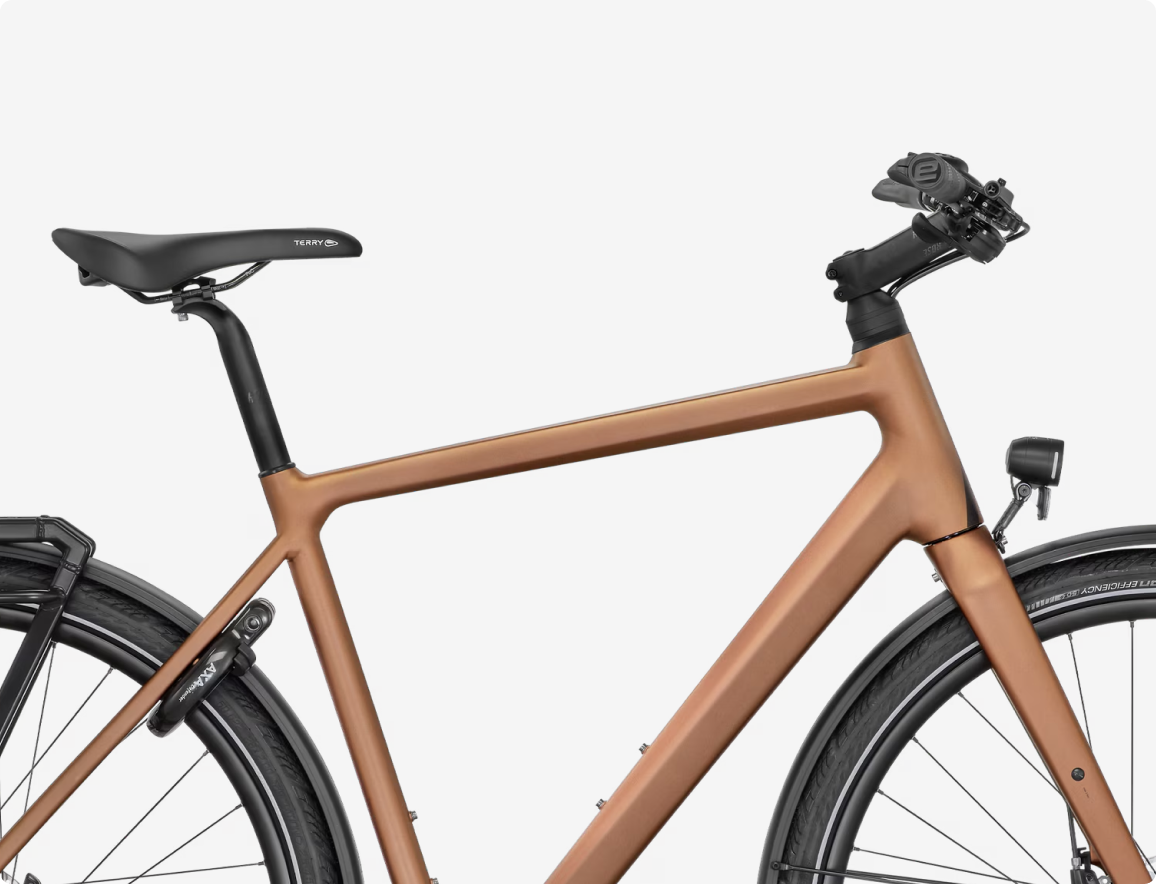Urban & Hybrid
Urban
Hybrid
Urban/Hybrid Bike Buyer’s Guide
FAQ
How can I protect my bike from theft?
Some city bikes already have an integrated frame lock for short stops. You can usually upgrade these with an additional chain. For longer stops, you should generally secure your bike to a fixed object. You can find a large selection of locks with different security levels as well as alarm and localisation devices in our shop.
Which accessories are recommended for city and hybrid bikes?
In addition to a good lock, a bicycle pump, repair kit and a bicycle helmet should be part of your basic equipment. Bicycle bags are also useful for errands or longer tours. Cleaning and care products are needed at the latest when riding in the rain frequently. The first tool should be a torque wrench to avoid overtightening screws. Popular accessories such as bike computers or mobile phone mounts are optional.
Are all city and hybrid bikes approved according to the StVZO?
All lighting systems installed by us comply with the StVZO. However, the required reflectors must be retrofitted to some urban bikes.
How do I adjust the riding position on a city bike?
The most important settings are the saddle height and the distance to the handlebar. Firstly, adjust the height so that you can still touch the pedal with your heel at the 6 o'clock position. Then move the saddle forwards or backwards so that in the 3 o'clock position (ball of the foot on the pedal) the kneecap is approximately vertically above the pedal axle. From this starting position, you can now slowly work your way up to your comfort position.
How should I store my bike in winter?
If you don't use your bike in winter, you should park it in a dry place out of direct sunlight if possible. With e-bikes in particular, it is important to ensure that the battery is stored protected from frost and is not charged in sub-zero temperatures. On some e-bikes, you can remove the battery for this purpose. If you do not use your battery for a longer period of time, you should store it at a charge level of approx. 40-60 per cent. It is generally advisable to wash the bike thoroughly and oil the drive unit before storing it. The tyre pressure should be checked from time to time to avoid a flat tyre.
Is a hybrid e-bike difficult to push?
Most e-bikes with heavier motors and handlebar remote control have a so-called walk assist. This means that the bike can be pushed comfortably on steps or slight climbs despite its higher weight.
Can I retrofit mudguards to my urban bike?
All ROSE bikes from the urban and hybrid segment are suitable to attach mudguards. To find out which mudguard fits your model, please contact our customer service.
Is there a weight limit for bicycles?
A maximum payload is specified for each bike, the so-called system weight. However, this does not only mean the weight of the rider, but also luggage, any bicycle trailers plus additional load and the bike itself. Just imagine riding your bike onto a weighbridge in full kit. This can add up quite a lot with everyday bikes.
Sample calculation:
15 kg (bike) + 80 kg (rider) + 5 kg (luggage) + 15 kg (child trailer) + 5 kg (child) = 120 kg
The bike must therefore have a system weight of at least 120 kg. /
The following table lists the respective system weight for our urban and hybrid bikes:
Sample calculation:
15 kg (bike) + 80 kg (rider) + 5 kg (luggage) + 15 kg (child trailer) + 5 kg (child) = 120 kg
The bike must therefore have a system weight of at least 120 kg. /
The following table lists the respective system weight for our urban and hybrid bikes:
Sneak
Hobo
Black Lava
Hobo
Black Lava
130 kg
110 kg
140 kg
110 kg
140 kg
Advantages and disadvantages of e-bikes:
Advantages
+ Longer tours
+ Steeper terrain
+ Less sweaty
+ Suitable for all fitness levels
Disadvantages
– Higher price
– Higher weight
– Dependent on electricity
– Higher maintenance costs
If you want to buy an e-bike, the motor power and battery capacity are important criteria. Steep, uneven terrain or a high total weight (bike, rider, luggage, child seat, trailer, etc.) require a more powerful motor, while long tours require a larger battery. An e-hybrid bike therefore requires more power than a pure e-city bike.
Factors influencing the range:
+ Longer tours
+ Steeper terrain
+ Less sweaty
+ Suitable for all fitness levels
Disadvantages
– Higher price
– Higher weight
– Dependent on electricity
– Higher maintenance costs
If you want to buy an e-bike, the motor power and battery capacity are important criteria. Steep, uneven terrain or a high total weight (bike, rider, luggage, child seat, trailer, etc.) require a more powerful motor, while long tours require a larger battery. An e-hybrid bike therefore requires more power than a pure e-city bike.
Factors influencing the range:
- Terrain and inclines
- Total weight
- Motor power and support level
- Riding style and speed
- Rolling resistance of the tyres
- Temperature and weather
)
)
)
)
)
)
)
)
)
)
)
)
)